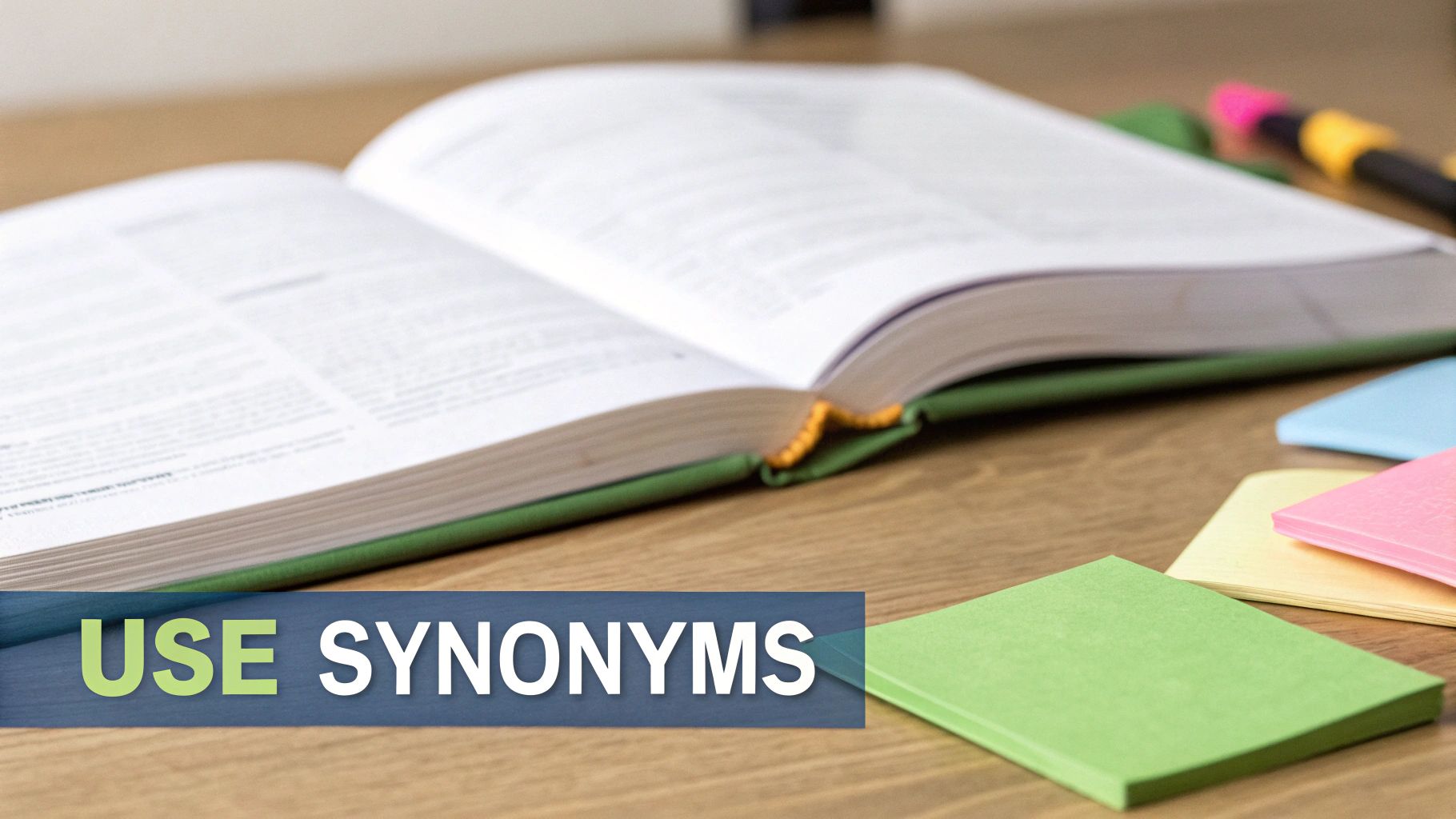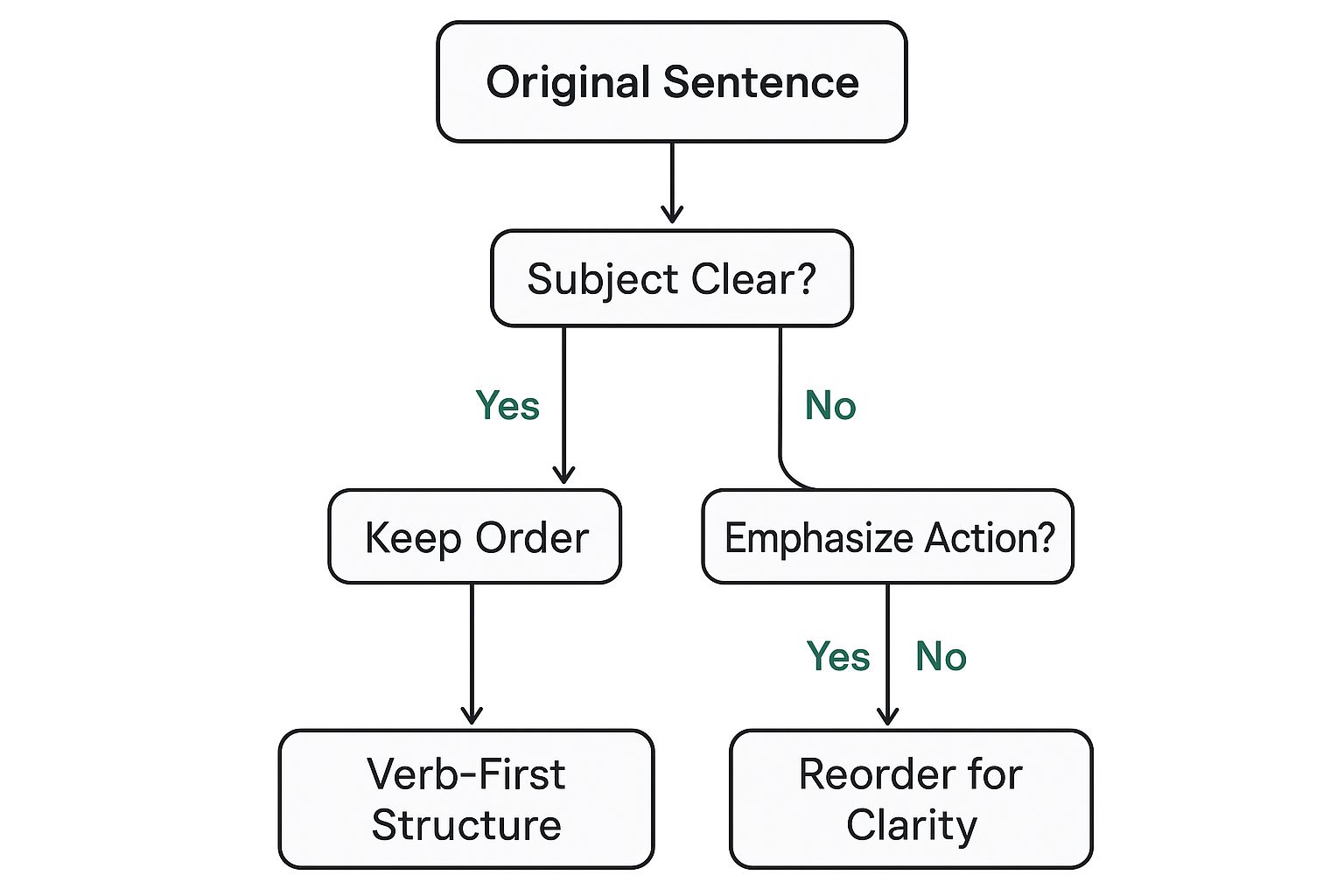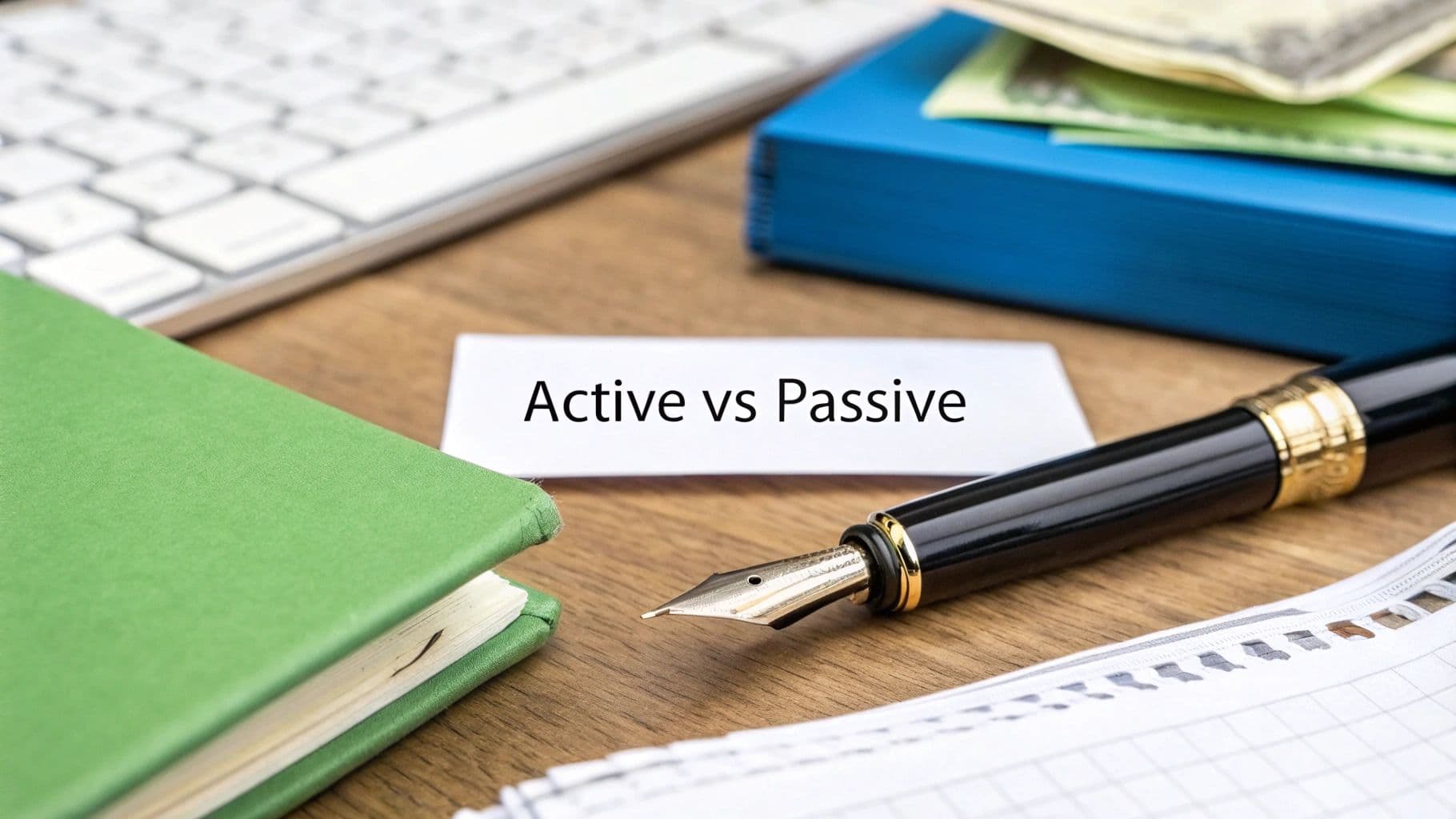
How to Rewrite a Sentence: Tips for Clarity and Impact
August 5, 2025
Knowing how to rewrite a sentence is a skill that goes way beyond just swapping out a few words. It's about spotting the weak points—like a clunky passive voice or unnecessary jargon—and then sharpening the entire thought. This means using stronger verbs, killing filler words, and mixing up your sentence structures to make your writing clearer and more impactful.
Why Mastering Sentence Rewriting Is a Skill You Need
 The ability to effectively rewrite a sentence isn't just some grammar-nerd exercise. It’s the secret sauce that separates forgettable writing from genuinely compelling communication.
The ability to effectively rewrite a sentence isn't just some grammar-nerd exercise. It’s the secret sauce that separates forgettable writing from genuinely compelling communication.
For anyone who writes for a living (or just wants to be understood)—whether you’re a student, a marketer, or a project manager—this skill is a game-changer. It’s the difference between a message that gets skimmed and one that actually sinks in.
Think about the last email or report that really grabbed your attention. It wasn't just the information, but how it was presented. The words just flowed, the ideas felt crisp, and the message stuck with you. That’s the magic of skillful rewriting.
The Real-World Impact of Clear Sentences
In a professional setting, every single word counts. A poorly worded sentence can muddy your point, chip away at your credibility, or just make your reader tune out completely. On the flip side, a sharp, well-crafted sentence can persuade a client, clarify a complex idea for your team, or convince a customer to click "buy."
Just look at how rewriting makes a difference in the real world:
- Marketing Copy: "Our product is designed for efficiency" is okay. But "Our product helps you finish projects 50% faster" is a specific, persuasive benefit.
- Academic Papers: "The study’s findings were indicative of a correlation" sounds weak. "The study found a clear correlation" makes your research sound confident and authoritative.
- Business Emails: "It would be appreciated if this could be done by Friday" is passive and wishy-washy. "Please complete this by Friday" is direct, professional, and leaves no room for confusion.
The heart of great communication isn't just having brilliant ideas; it's presenting them in a way that’s impossible to misunderstand. Rewriting is how you close that gap.
Good sentence rewriting can dramatically improve clarity and impact. The table below shows a few "before and after" examples to illustrate how a few tweaks can transform a message.
Original vs Rewritten Sentence Impact
| Problem Area | Original Sentence (Confusing) | Rewritten Sentence (Clear) | Improvement |
|---|---|---|---|
| Passive Voice | The report was submitted by the team late. | The team submitted the report late. | Direct and active; clearly assigns responsibility. |
| Wordiness | In my personal opinion, it is necessary that we... | I think we need to... | Concise and natural; removes unnecessary filler. |
| Vague Language | We need to make some improvements to the process. | Let's streamline our invoicing process to reduce errors. | Specific and actionable; provides clear direction. |
| Complex Structure | The system, which was recently updated, has issues. | The recently updated system has issues. | Simpler and easier to read; gets to the point faster. |
As you can see, the rewritten sentences aren't just grammatically correct—they're more direct, powerful, and easier for the reader to process.
Beyond Correctness to Connection
Ultimately, learning how to rewrite a sentence is about more than just avoiding red squiggly lines in your document. It’s about building a connection with your reader. Polished, intentional writing builds trust and signals professionalism. When your sentences are clear, concise, and purposeful, your audience is far more likely to see you as a credible expert.
This ability is a cornerstone of many professional roles, especially for anyone aiming for Quality Assurance Editor Mastery. It's not just a "nice-to-have" skill—it’s an essential part of succeeding in any field that depends on clear written communication.
Fundamental Techniques for Manual Sentence Rewriting
Before you even think about using a tool, you have to get your hands dirty. Learning how to rewrite a sentence starts with understanding what makes it tick. These are the foundational, hands-on methods that form the bedrock of any strong piece of writing.
Think of it like a chef mastering knife skills before ever touching a food processor. The raw skill is what makes the technology powerful. This groundwork is non-negotiable for anyone who wants to communicate with real impact.
Activate Your Sentences by Killing the Passive Voice
One of the fastest ways to breathe life and clarity into your writing is to hunt down the passive voice and get rid of it. Passive sentences are often wordy, a little vague, and can hide who’s actually doing the action.
- Passive: The marketing report was completed by the team. (9 words)
- Active: The team completed the marketing report. (6 words)
The active version isn’t just shorter—it’s more direct and confident. It puts the "doer" (the team) right at the front, giving the sentence a dynamic feel. A quick tip for spotting it: look for forms of the verb "to be" (like is, are, was, were) followed by a past participle (like "completed" or "written").
Pro-Tip: Writing in the active voice forces you to be decisive. Instead of a wishy-washy phrase like "mistakes were made," an active sentence demands you state who made the mistakes. That tiny shift builds accountability and trust.
Slash and Burn All Filler Words
Filler words are the weeds of your writing. They pop up everywhere, take up valuable space, and add absolutely no value. Words like "just," "really," "basically," and "that" often do nothing but weaken your message. Getting good at spotting and slashing them is a critical rewriting skill.
Take this sentence, for example:
- Original: I think that we should basically just try to implement a really new strategy.
- Rewritten: We should implement a new strategy.
The second version is sharper and far more assertive. It gets straight to the point because every single word serves a purpose. When you're editing, question every adverb and qualifying phrase. Does it add essential meaning? If the answer is no, delete it without mercy.
Break Down Complexity for Clarity
Long, meandering sentences are a surefire way to confuse your readers and make your content impossible to scan. A key technique is breaking down those big, complex ideas into shorter, more digestible sentences. This doesn't mean every sentence has to be choppy, but it stops your reader from getting lost in a maze of clauses.
Imagine you’re explaining a technical update:
- Complex: The user authentication system, which was recently updated to enhance security protocols across all platforms, now requires a multi-factor authentication process that sometimes causes delays for users who haven't updated their mobile apps.
- Rewritten: The user authentication system was recently updated to enhance security. It now requires multi-factor authentication across all platforms. However, this may cause delays for users with outdated mobile apps.
The rewritten version uses three clean sentences to deliver the same information. Each one tackles a single part of the idea, making it much easier for someone to follow along. These manual skills are just the start; you can explore our guide for more advanced paraphrasing techniques for 2025 to take your writing even further.
Using AI Sentence Rewriters to Elevate Your Writing
 Once you have the manual techniques down, you can bring in some powerful backup. AI sentence rewriters are much more than a fancy thesaurus. Think of them as an intelligent partner in your writing process, especially when you’re stuck and just can't find the right words.
Once you have the manual techniques down, you can bring in some powerful backup. AI sentence rewriters are much more than a fancy thesaurus. Think of them as an intelligent partner in your writing process, especially when you’re stuck and just can't find the right words.
These tools aren't here to replace your voice or your ability to think critically. Not at all. A better way to see them is as a fresh set of digital eyes that can instantly offer different ways to say the same thing. This can be a lifesaver for breaking through writer's block, playing with different tones, or just refining a message for a specific audience.
The key is to work with the AI, not just blindly accept its first suggestion.
Finding Your Way Through the AI Rewriter Jungle
The market for these tools has completely exploded. It feels like there's a new one every week, with options for just about any workflow or budget. The old ways of rewriting a sentence have been totally upended, with a landscape now featuring over 30 different AI rewriting tools.
Big names like Team-GPT, Ahrefs, QuillBot, and Grammarly are leading the charge, offering everything from free browser add-ons to full-blown premium platforms with all the bells and whistles.
You can see in the screenshot below how a tool like QuillBot gives you different "modes" to nudge the AI toward a certain style or tone.

See those modes like "Standard," "Fluency," and "Creative"? That's how you steer the output. You can go for simple clarity or something a bit more expressive, depending on what you need.
When you're just starting out, I'd recommend trying a free version first to see if it even fits your process. A lot of writers I know get by just fine with a simple browser extension for daily tasks. Others might need the more robust features of a paid plan, like plagiarism checks or advanced tone adjustments.
How to Use an AI Rewriter Strategically
To really get your money's worth (even if it's free), you need a game plan. Don't just dump your text in and copy whatever comes out. Use it as an interactive tool to spark ideas and sharpen your own writing instincts.
Here are a few real-world scenarios where they come in handy:
- Breaking Repetitive Rhythms: Ever notice you've started three sentences in a row the same way? An AI rewriter is great for suggesting structural variations to make your writing more dynamic.
- Shifting Your Tone: You can take a stuffy, formal sentence from a report and ask the AI to make it sound more conversational for a blog post or social media update.
- Untangling Complex Ideas: When a sentence gets long and messy, a rewriter can often chop it down into a clearer, more direct version that just makes more sense.
The real magic of an AI rewriter is its ability to show you possibilities you hadn't even considered. It's a brainstorming partner that helps you refine, not replace, your original thoughts.
Of course, a huge part of using these tools is making sure the final text sounds genuinely human. While AI is fantastic for generating options, the output can sometimes get flagged by AI detectors. It's always a good idea to run it through a final check. We have a guide on how to bypass AI detection that can help you polish the text so it keeps that human feel.
Beyond just fixing sentences, AI can become a core part of your entire content workflow. If you're curious about the bigger picture, learning about writing blogs with AI can give you some valuable context. By integrating these tools thoughtfully, you can improve both how fast you work and how good the final product is.
Choosing the Right AI Rewriting Tool for Your Needs
With so many AI rewriters flooding the market, picking the right one can feel overwhelming. It’s easy to get lost in feature lists and marketing jargon. But finding the best tool really just boils down to a few key factors that actually matter.
Instead of getting distracted by flashy promises, I find it’s best to focus on the core functions that will genuinely improve your writing process. The goal is to find a reliable assistant that helps you rewrite sentences for clarity and impact, not create more work for yourself.
Evaluate Contextual Accuracy and Meaning
The most important feature of any AI sentence rewriter is its ability to understand context. A tool that just swaps out words can easily distort your original meaning, leaving you with awkward or flat-out incorrect sentences. The best tools go beyond a simple thesaurus; they analyze the entire thought to offer relevant, meaningful alternatives.
This is where modern technology makes a huge difference. The integration of advanced language models like GPT-3.5 marks a massive leap in accuracy. These models use an astonishing 175 billion parameters to analyze text, ensuring the core meaning stays intact. As more people use these tools, the underlying models learn and improve, which means the suggestions only get better. You can learn more about how these models refine content on Originality.ai.
Match the Tool to Your Primary Goal
Not all rewriters are built the same because not all writing tasks are the same. A student polishing an academic essay has very different needs than a marketer crafting snappy ad copy.
Before choosing, ask yourself what you’ll be using it for most often:
- Academic and Formal Writing: Look for tools that prioritize grammatical precision, citation support, and maintaining a formal tone. Here, accuracy is everything.
- Marketing and Creative Content: Prioritize tools with robust tone and style adjustments. The ability to switch from a professional to a witty or persuasive voice is essential.
- Everyday Efficiency: For quick email edits or cleaning up internal documents, a simple, fast browser extension might be all you need.
This infographic breaks down a simple way to think about rearranging sentence elements to improve flow and clarity.

As the chart shows, the first step is always to check if the subject is clear. From there, you can decide whether to emphasize the action or simply reorder for better readability. It's a fundamental part of the rewriting process.
Consider Usability and Workflow Integration
The best tool is one you’ll actually use. I’ve seen powerful platforms that just collect digital dust because they're a pain to use. A complicated interface or a clunky user experience will just slow you down, defeating the whole purpose of an AI assistant.
Key Takeaway: A powerful tool is useless if it disrupts your workflow. Look for solutions that integrate smoothly with the programs you already use, like Google Docs or Microsoft Word, or offer a clean, intuitive web interface.
My advice? Test out the free versions or trials of a few different platforms. See which one feels the most natural to you. Pay attention to how quickly it provides suggestions and how easy it is to accept, reject, or modify them. Ultimately, the right tool should feel less like a hurdle and more like a natural extension of your own editing process.
Advanced Strategies for Adjusting Tone and Flow
 Grammar is just the starting line. Truly great writing isn’t just correct—it has personality. Once you’ve nailed the basics, the next step is to intentionally shape your reader’s experience. Adjusting tone and flow is how you turn a dry statement into a persuasive argument or a confusing paragraph into a smooth, compelling story.
Grammar is just the starting line. Truly great writing isn’t just correct—it has personality. Once you’ve nailed the basics, the next step is to intentionally shape your reader’s experience. Adjusting tone and flow is how you turn a dry statement into a persuasive argument or a confusing paragraph into a smooth, compelling story.
This is the more artistic side of rewriting sentences. It forces you to get inside your audience's head and pick words that create a specific feeling. Whether you want to sound authoritative, friendly, or urgent, the right word choice and sentence rhythm make all the difference.
Crafting Your Tone with Precision
Think of tone as the attitude your writing projects. Is it a formal, academic paper or a casual, conversational blog post? A mismatched tone can instantly alienate your reader. Throwing casual slang into a business proposal undermines your professionalism, but a stiff, overly formal tone in a friendly email can make it unreadable.
To get your tone right, you need to focus on two things: word choice (diction) and sentence structure.
- Formal Tone: This calls for precise, sophisticated vocabulary. You'll want to avoid contractions and slang, and you’ll likely use longer, more complex sentences.
- Conversational Tone: Here, you should lean into simpler, more common words. Contractions (like "it's" or "you're") and shorter, punchy sentences help create a friendly, approachable feel.
- Persuasive Tone: This is where you bring in strong verbs, emotional language, and rhetorical questions. Your goal is to guide the reader toward your point of view without being pushy.
The most effective writers are chameleons. They adapt their tone to fit the audience and the purpose. Your goal isn't just to be understood, but to connect with the reader on the right level.
Mastering the Elusive Quality of Flow
Flow is that invisible current that pulls a reader from one sentence to the next without any friction. When your writing has good flow, reading it feels effortless. When it’s choppy, the reader has to work too hard, and they’re far more likely to just give up.
So, how do you achieve it? It comes down to a few small but powerful techniques. One of the most effective is using transition words. We dive deeper into this in our post on advanced writing revision strategies for 2025, but here’s a quick look.
Examples of Transition Words:
- To add an idea: additionally, furthermore, moreover
- To show contrast: however, but, on the other hand
- To show a result: therefore, consequently, as a result
These little words act like signposts for your reader, signaling the relationship between your ideas and creating a logical path for them to follow.
Another huge part of flow is maintaining a consistent point of view. Abruptly switching from "you" to "one," or from a personal to an impersonal perspective, is jarring. It breaks the reader's concentration. Sticking with a single viewpoint throughout your piece builds trust and makes your writing feel cohesive and much easier to follow.
Common Questions About Rewriting Sentences
https://www.youtube.com/embed/pYb7p0DiVMI
Even with the best techniques, a few questions always seem to pop up. Learning how to rewrite sentences is a skill, and like any skill, it comes with a bit of uncertainty at first. Here are some straightforward answers to the questions I hear most often.
Can an AI Rewriter Change My Meaning?
Yes, and you should assume it might. While modern AI rewriters are remarkably good at grasping the core message, they don’t have your brain. They can easily miss the subtle nuances, the specific tone you were going for, or the context that’s obvious to you but invisible to an algorithm.
This is exactly why human oversight is non-negotiable. Think of AI suggestions as a first pass—a helpful starting point, but never the finished product. Your job is to double-check every change to make sure it still says what you mean before you hit publish.
Is Using a Sentence Rewriter Plagiarism?
This is a big one, but it really comes down to how you use the tool.
If you’re using a rewriter to sharpen your own original ideas—to improve clarity, fix clunky phrasing, or find a stronger word—that’s perfectly fine. It’s no different than using a thesaurus or asking a friend to proofread your work.
The line gets crossed when you use a tool to pass off someone else’s work as your own. Running copied content through a rewriter to shuffle the words is plagiarism, pure and simple. The key is to use these tools as an aid for your ideas, not a disguise for stolen ones.
How Often Should I Rewrite Sentences?
There’s no magic number here. You don’t need to hit a quota. The need to rewrite a sentence usually makes itself obvious during the editing process.
A great trick is to read your draft aloud. You’ll hear it immediately. If a sentence is awkward, drags on too long, or makes you stumble, it’s a perfect candidate for a rewrite. The goal isn't to rewrite for the sake of rewriting; it's to make every sentence land with clarity and impact.
What Is the Most Important Manual Rewriting Technique?
If you only have time to master one thing, make it this: switching from passive voice to active voice. It’s a small change with a huge payoff. Your writing instantly becomes more direct, confident, and punchy.
Just look at the difference:
- Passive: The report was approved by the committee.
- Active: The committee approved the report.
The active version is shorter and clearer. It tells you who did the action. Nailing this one skill will dramatically strengthen your writing.
Ready to transform your AI-generated text into clear, natural, and undetectable writing? Natural Write instantly humanizes your drafts, refining tone and clarity with a single click while bypassing all major AI detectors. Try Natural Write for free and elevate your writing today!


